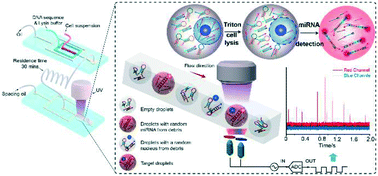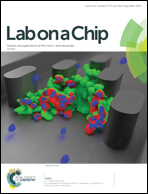Ultrahigh-throughput droplet microfluidic device for single-cell miRNA detection with isothermal amplification†
Abstract
Analysis of microRNA (miRNA), a pivotal primary regulator of fundamental cellular processes, at the single-cell level is essential to elucidate regulated gene expression precisely. Most single-cell gene sequencing methods use the polymerase chain reaction (PCR) to increase the concentration of the target gene for detection, thus requiring a barcoding process for cell identification and creating a challenge for real-time, large-scale screening of sequences in cells to rapidly profile physiological samples. In this study, a rapid, PCR-free, single-cell miRNA assay is developed from a continuous-flow microfluidic process employing a DNA hybridization chain reaction to amplify the target miRNA signal. Individual cells are encapsulated with DNA amplifiers in water-in-oil droplets and then lysed. The released target miRNA interacts with the DNA amplifiers to trigger hybridization reactions, producing fluorescence signals. Afterward, the target sequences are recycled to trigger a cyclic cascade reaction and significantly amplify the fluorescence signals without using PCR thermal cycling. Multiple DNA amplifiers with distinct fluorescence signals can be encapsulated simultaneously in a droplet to measure multiple miRNAs from a single cell simultaneously. Moreover, this process converts the lab bench PCR assay to a real-time droplet assay with the post-reaction fluorescence signal as a readout to allow flow cytometry-like continuous-flow measurement of sequences in a single cell with an ultrahigh throughput (300–500 cells per minute) for rapid biomedical identification.

- This article is part of the themed collection: Droplet-based single-cell sequencing


 Please wait while we load your content...
Please wait while we load your content...